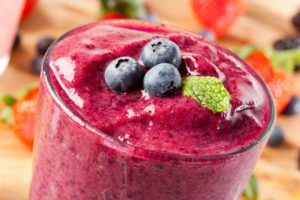Protein isn’t just for bodybuilding meatheads – it’s essential for building every single cell in your body, from your hair, skin, and nails, to yes, your muscles. And getting enough protein in your diet is essential to your body composition – how much body fat versus lean muscle mass you carry.
If you have a goal of leaning out or toning up, getting more protein in your diet should be your number one focus outside of the gym. For the guys out there looking to “bulk up,” it’s essential to eat enough protein to give your body the building blocks for new muscle. (But don’t worry, ladies, eating more protein won’t turn you into the Hulk, just like putting high-octane fuel into your gas tank wouldn’t turn your car into a drag racer.)
How much is “enough” protein?
To support training, recovery, and lean muscle, the research indicates that eating 0.8-1.2 grams of protein per pound of your bodyweight is most effective. This averages out to 1g per pound, which is nice because it makes for simple math. If you weigh 150 lbs, you should try to eat 150g of protein each day. You can track this with an app like My Fitness Pal or Lose It.
How do I hit my protein target?
You might notice after a few days of tracking your diet that it’s challenging to actually eat that much protein! No worries, with a few simple strategies, you’ll hit your target and support lean muscle growth and fat loss. Here’s how:
- Include a protein source at each meal. Whenever you eat, build your meal around protein. Good sources include lean meat, fish, eggs and egg whites, plain yogurt, cottage cheese, beans, and high-protein grains like quinoa.
- Choose lean, low-fat meat and fish. Leaner cuts (like 90-95% ground beef or cuts with “loin” in the name) have a higher percentage of calories from protein instead of fat. Not that fat is bad for you, but leaner cuts will pack a bigger protein punch with less of a calorie investment, helping you stick to a calorie range that promotes fat burning.
- Switch to high-protein carbs. When you grocery shop, read labels on carbs like pasta, oats, and bread. Opt for whichever version has more protein. For instance, the P28 brand makes high-protein breads and wraps that have 28g of protein per serving (2 slices of bread). Dave’s Killer Bread and Ancient Harvest “Protein Pow” pasta are other good choices.
- Swap traditional toppings for high-protein sources. Using plain Greek yogurt on your baked potato instead of standard sour cream saves you one-third of the calories while boasting five times as much protein (100g of Greek yogurt contains 59 calories and 10g of protein; 100g sour cream contains 159 calories and only 2g of protein). You can add Greek yogurt to soups and smoothies for a protein boost, too.
- Reach for high-protein snacks. Good options include jerky, Greek or plain yogurt, low-fat string cheese, cottage cheese, hard-boiled eggs, and in a pinch – protein bars or shakes. Another option for those with a sweet tooth is Halo Top ice cream
- Supplement with protein powder. If you’re still having trouble hitting your protein goal, supplement.
 Which protein powder you choose can depend on a number of factors. Look for a powder with 20-30g protein per serving, and less than 5g of sugar. If you tolerate dairy, whey protein isolate (not concentrate) is best; otherwise, opt for a vegan/vegetarian protein powder like Vega One. Generally, I advise people to avoid soy protein supplements because the protein isn’t as bioavailable (your body can’t use it as well as other kinds of protein).
Which protein powder you choose can depend on a number of factors. Look for a powder with 20-30g protein per serving, and less than 5g of sugar. If you tolerate dairy, whey protein isolate (not concentrate) is best; otherwise, opt for a vegan/vegetarian protein powder like Vega One. Generally, I advise people to avoid soy protein supplements because the protein isn’t as bioavailable (your body can’t use it as well as other kinds of protein).
In the end, the most important deciding factor is personal preference – if you don’t like the taste/texture, you won’t enjoy drinking the protein shake, and therefore won’t be willing to use the supplement. My personal favorite is Ascent Native Fuel whey protein because it tastes delicious, mixes well with just water, and uses only natural ingredients without fillers.
Remember, the best thing you can do to lean out or build muscle is to eat enough protein. Aim for 1g of protein per pound of your bodyweight as a daily target, and track this with a food logging app. Using the tips in this article, you should have plenty of ammo for hitting that target. Getting enough protein will help boost your metabolism, keep you feeling full and satisfied between meals, and aid in recovery between workouts so that you can build muscle and lean out.
